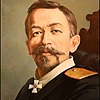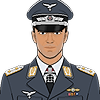HOME | DD
 PieJaDak — Kornilov Shock Regiment, Uniforms (HIS)
PieJaDak — Kornilov Shock Regiment, Uniforms (HIS)

#alternatehistory #alternateuniverse #digitalart #digitalartwork #fantasy #fantasyart #imperial #kornilov #markov #military #militaryuniform #monarch #monarchy #pixelart #russia #russian #tsar #whitearmy #ww1 #ww1worldwar #whiteguard #monarchism #ww1worldwar1 #alekseyev #ww1soldier #various #imperialrussianarmy #ww1russia #gimnastyorka #russiancivilwar
Published: 2022-02-09 21:00:15 +0000 UTC; Views: 24306; Favourites: 120; Downloads: 52
Redirect to original
Description
Backstory:
The Volunteer Army (Russian: Добровольческая армия, romanized: Dobrovolcheskaya armiya, abbreviated to Russian: Добрармия, romanized: Dobrarmiya) was a White Army active in South Russia during the Russian Civil War from 1917 to 1920. The Volunteer Army fought against Bolsheviks on the Southern Front and the Ukrainian War of Independence. In 1919 it was made part of the Armed Forces of South Russia, becoming the largest force of the White movement until it was merged with the Army of Wrangel in March 1920.
The Volunteer Army began forming in November/December 1917 under the leadership of General Mikhail Alekseyev and General Lavr Kornilov in Novocherkassk, shortly after the Russian Civil War began following the October Revolution. It organized to fight against the Bolsheviks in South Russia. Alekseyev and Kornilov enlisted supporters, which initially included volunteering officers, cadets, students, and Cossacks. Of the first 3,000 recruits, only twelve were ordinary soldiers; the rest were officers, some of whom resented having to serve as privates.
On December 27, 1917 (January 9, 1918), the creation of the Volunteer Army was officially announced, with Alekseyev becoming its overall leader, Kornilov as its Commander-in-chief, General Alexander Lukomsky as its Chief of Staff, General Anton Denikin commander of the 1st Division, and General Sergey Markov as commander of 1st Officers regiment. They also created the so-called "Special Council" at the headquarters, which included prominent civilian politicians such as Peter Struve, Pavel Milyukov, Mikhail Rodzianko, Sergey Sazonov and Boris Savinkov.
In early February 1918, the Volunteer Army numbered more than 3,600 men. It fought against the Red Army together with units of General Alexey Kaledin's forces. A “1st Partisan Infantry Regiment” was named after General Alekseyev (Alexey) later on. Another notable unit of the Volunteer army was the 1st Kornilov Shock Regiment and, in general, the White Guard units were considered elite amongst the rest of the volunteers.
In late February, the Red Army's advance forced the Volunteer Army to retreat from Rostov-on-Don to Kuban in order to unite with the Kuban Cossack formations, a retreat known as the Ice March. However, most Kuban Cossacks did not support the Volunteer Army, and only a small unit (3,000 men) led by General Viktor Pokrovsky joined the Volunteer Army on March 26, 1918, increasing its number to 6,000 troops. The Volunteer Army's attempt to capture Yekaterinodar between April 9–13 was a disaster, with Kornilov being killed in battle when he was hit by an artillery shell. Denikin took over command of the remnants of the Volunteer Army and left for the remote stanitsas beyond the Don River region.
In June 1918, 3,000 men under Colonel Mikhail Drozdovsky's command joined the Volunteer Army, strengthening it to between 8,000 to 9,000 men. On June 23, the Volunteer Army began its so-called Kuban Offensive, with General Pyotr Krasnov's support. By September 1918, the Volunteer Army was up to 30,000 to 35,000 men thanks to the mobilization of the Kuban Cossacks and "counterrevolutionary elements" gathered in the North Caucasus, taking the name of Caucasus Volunteer Army.
In the autumn of 1918, Great Britain, France and the United States increased their material and technical assistance to the Volunteer Army. With the Entente's support, the forces of the South Russian Whites combined to form the so-called Armed Forces of South Russia (Вооружённые силы Юга России, Vooruzhenniye sily Yuga Rossii) led by Denikin. In late 1918 to early 1919, Denikin defeated the 11th Soviet Army and captured the North Caucasus region.
In January 1919, the Caucasus Volunteer Army was divided into the Caucasus Army and the Volunteer Army, which would later be joined by the Don Army, created from the remnants of Krasnov's Cossack Army. After capturing Donbass, Tsaritsyn, and Kharkov in June 1919, Denikin began advancing towards Moscow on June 20 (July 3). According to his plan, the main blow to Moscow was to be inflicted by the Volunteer Army (40,000 men) under the command of General Vladimir May-Mayevsky.
The Bolsheviks accused the White Army of cruelty in its conquered territories, usually against the workers, and the Soviet historiography dubbed this regime "Denikinschina". Some of the Volunteer Army's units and formations possessed good military skills and fighting strength due to large numbers of officers in its ranks, who hated and despised the Bolsheviks. However, the Volunteer Army's fighting efficiency decreased in the summer of 1919 in light of significant losses and conscription of mobilized peasants and even captured Red Army soldiers. During the Red Army's counteroffensive in October 1919, the Volunteer Army suffered a decisive defeat and retreated south.
In early 1920, it retreated to the areas beyond the Don region and was reduced to a corps of 5,000 men under the command of General Alexander Kutepov. On March 26 and March 27, 1920, the Volunteer Army's remnants were evacuated from Novorossiysk to the Crimea, where they merged with the Army of Wrangel under General Pyotr Wrangel.
The Volunteer Army has been criticized for its poor treatment of political prisoners and the prisoners' respective communities during the Russian Civil War.
K.N. Sokolov, an anti-Bolshevik activist and Constitutional Democratic Party politician who advocated for the Russian government's movement toward a constitutional monarchy, lambasted this characteristic of the Volunteer Army. Sokolov wrote:
“The uncontrollable robbery of the population by our military forces, the debauchery and repression by military officials in local areas, the unbelievable corruption of the representatives of power, their open speculation, venality, and, finally, their unrestrained arbitrariness prevailing in their counterintelligence organizations, here were the ulcers of our regime, compelling the population to say: no, this is not the regime that can save Russia.”
Edward M. Dune, a member of the Red Guards, the organization that eliminated the Constitutional Democratic Party power after the Russian Revolution in 1917, compared the Red Army's poor behaviour to that of the Volunteer Army. For instance, in reference to the Kuban Cossacks rebellion, Dune explains: "Our actions … differed little from the behaviour of the White Army during the war itself."
The propaganda service of the Volunteer Army, the Osvag [ru] (Russian: ОСВАГ (ОСВедомительное АГентство), romanized: OSVAG (OSVedomitelnoe AGentstvo), lit. 'Informing Agency'), made the claim that "the Jews must pay for everything: for the February and October revolutions, for Bolshevism and for the peasants who took their land from the owners". The organization also reissued the Protocols of the Elders of Zion.
Although Denikin's troops committed only 17.2% of the pogroms (most of which were carried out by Ukrainian nationalists or by rebel armies not affiliated with any side), "white" officers praise soldiers who commit anti-Semitic crimes, some of whom even receive bonuses.
The Volunteer Army nevertheless benefited from funding from wealthy Jews: banker Abraham Halperin paid 800,000 rubles to Cossack ataman Alexei Kaledin. Zionist leader Daniel Pasmanik [ru], president of the Union of Jewish Communities of Crimea, called for "bowing in prayer before the White Army" for his "self-sacrificing struggle against the Bolsheviks". Abroad, anti-Semitic massacres became a concern for European and American donors. Winston Churchill, then a British Cabinet Minister, called on Denikin to prevent the killing of Jews in districts controlled by his army. However, Denikin did not dare to confront his officers and remained content with vague formal condemnations.
The term "Volunteer Army" is often used as a shorthand description for all the White Russian forces in the South Russia area, the actual names of the formation are:
· From its inception until January 23, 1919, this formation was named the Volunteer Army.
· From January 23, 1919, until May 22, 1919, this formation was named the Caucasus Volunteer Army.
· On May 22, 1919, this formation was split into two formations:
o Caucasus Army, disbanded on January 29, 1920 and replaced by the Kuban Army, the remnants of which surrendered on April 18–20, 1920.
o Volunteer Army, the remnants of which were evacuated March 26/27, 1920.
Uniform:
The uniform of special formations of the Volunteer Army were black with white piping on the upper pocket flaps, at the wrists of the sleeve, the collar and along the button seams, they also had a white stripe on their breeches and trousers. The shoulder boards generally followed Imperial Army regulation, safe for the fact infantry was indicated by white shoulder strap piping. The black uniforms even before the Russian Civil War denoted elite status amongst the rest of the Imperial Russian Army and thus was continued into the Volunteer Army. Enlisted personnel wore the Gimnastyorka uniform, whilst officers wore the Model 1907.
Specifically for the Kornilov Shock Regiment, named after Lavr Kornilov, the uniform was one of the most unique amongst the White forces. They had shoulder straps split into two coloured halves, one red and one black, reminiscent of the regiment’s banner, which also is split diagonally into those colours. On the left sleeve it displayed the regimental patch, a skull with swords pointed downwards, a flaming grenade on the bottom and Cyrillic writing on the top on a blue background and a chevron with white, red and blue, the Russian national colours. On the right sleeve a chevron split into red and black could be seen, again representing the regimental colours. The cap was standard Russian infantry style with a black band and red top with white piping on both. The cockade displayed the black and gold standard colours of the Tsar, but sometimes this was changed for a skull and crossed bones, a symbol generally associated with shock troops.
Disclaimer: I do not support any of the views these people might have had, this is just for creative purposes and alt-history curiosity!
Credit to TheRanger1302 for the base uniform, base headgear and the male body.
The gimnastyorka uniform, the Tarist cap insignia, the shoulder straps, the enlisted insignia for all ranks, and modelling of the Russian cap was all done by me.
The tools used for this work are: www.deviantart.com/theranger13… and www.deviantart.com/theranger13…
Related content
Comments: 21

👍: 0 ⏩: 1

👍: 0 ⏩: 1

👍: 0 ⏩: 1

👍: 0 ⏩: 1

👍: 0 ⏩: 1

👍: 0 ⏩: 1

👍: 0 ⏩: 1

👍: 0 ⏩: 0

👍: 1 ⏩: 0

👍: 0 ⏩: 0

👍: 0 ⏩: 1

👍: 1 ⏩: 1

👍: 0 ⏩: 1

👍: 0 ⏩: 1

👍: 0 ⏩: 1

👍: 1 ⏩: 1

👍: 0 ⏩: 1

👍: 0 ⏩: 0

















